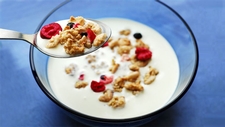Mixtures that Maintain Physical Properties of their Ingredients
Supporting

TEKS Objective
Students will demonstrate that some mixtures maintain physical properties of their ingredients such as iron filings and sand.
Essential Understanding
The student knows that (1) matter has measurable physical properties and (2) those properties determine how matter is classified, changed and used.
Science Background
Separating Mixtures: General Chemistry Online! (website) - Easy-to-read chart identifies different ways to separate mixtures, from magnets to filtration.
Separating Mixtures
by Fred Senese, General Chemistry Online, www.antoine.frostburg.edu
A Magnetic Personality: TeachEngineering (website) - Introductory lesson on magnetism with a good background section on magnets.
A Magnetic Personality
TeachEngineering, www.teachengineering.org
Mixtures: Virtual Education (website) - Short page with straightforward explanations of mixtures, solutions, suspensions and colloids.
Mixtures
Monroe County Women's Disability Network, www.mcwdn.org
Signature Lesson
Eat Iron? TeachEngineering (website) - Students learn that components of a heterogeneous mixture (corn flake cereal) conserve their properties, and also investigate ways to physically separate the mixture’s components, using a magnet.
- Supporting Lessons
- Extensions
- Assessment Ideas
- Literature Connections
- Related
TEKS - Additional Resources
Supporting Lessons
Separation of a Mixture: Alabama Learning Exchange (website) - Students explore mixtures, recognize that a mixture is created when two or more materials are combined, and design their own procedures for separating a mixture of four ingredients.
Separation of a Mixture
Alabama Learning Exchange, http://alex.state.al.us
Messin’ with Mixtures: TeachEngineering (website) - Students investigate the properties of trail mix, a heterogeneous mixture, as if it were a contaminated soil sample. They learn that physical means can be used to separate heterogeneous mixtures into their component parts, and that when separated, all the parts equal the whole.
Messin’ with Mixtures
TeachEngineering, www.teachengineering.org
Properties of Mixtures and Solutions: University of Virginia (website) - Students make observations, organize and analyze information, and measure and record data while identifying, separating and determining the concentrations of components in mixtures.
Properties of Mixtures and Solutions
University of Virginia, http://galileo.phys.virginia.edu
Elaboration Lessons and Extensions
Homogeneous and Heterogeneous Mixtures: TeachersNet (website) - Provides examples of six different simple mixtures (sand and water, for example) to use with students.
Homogeneous and Heterogeneous Mixtures
TeachersNet, http://teachers.net
Mixtures and Solutions Lesson Plans, Worksheets, Printables: Plan It (website) Search Plan It allows you to find lessons and other resources on the area of physical science.
Mixtures and Solutions Lesson Plans, Worksheets, Printables
Plan It, www.searchplanit.com
Assessment Ideas
- Have students create a chart of sample mixtures and non-mixtures.
- Give students performance assessments that challenge students to separate different types of mixtures.
- Make a mixture of salt, sand and iron filings and ask students to devise and test a plan to separate the three components.
-
Have students create different mixtures and explain the properties of each.
-
Have students research different types of mixtures and how they are used in everyday life.
Literature Connections
Mix It Up! Solution or Mixture? Nelson, Tracy (ISBN-13: 978-1618102270)
Matter. Cooper, Christopher (ISBN-13: 978-0751361353)
Salt. Walpole, Brenda (ISBN-13: 978-1560740605)
Iron. Hasan, Heather (ISBN-13: 978-1404201576)
Mixtures and Solutions: Why Chemistry Matters. Aloian, M. (ISBN-13: 978-0778742500)
Mixtures and Solutions: Reading Essentials in Science. Karpelenia, J. (ISBN-13: 978-0756946425)
Additional Resources
Cleaning Water: ACS Chemistry for Life (website) - Investigate what it takes to clean up wastewater.
Cleaning Water
by the American Chemistry Society, www.acswebcontent.acs.org
Mixtures and Solutions: Science-class.net (website) - Links to activity labs, quizzes, sideshows, and other resources to help you present and teach concepts related to mixtures and solutions.
Mixtures and Solutions
Science-class.net, science-class.net
TEKS Navigation
Grade 5
User Information
Not Registered Yet?
Sign Up Today!
Need Assistance?
If you need help or have a question please use the links below to help resolve your problem.

Comments